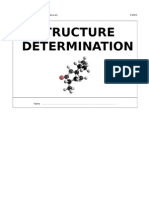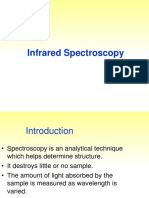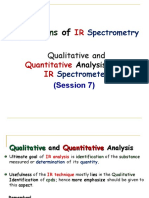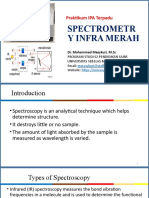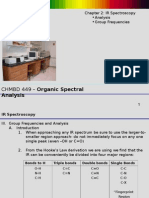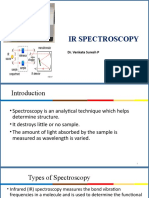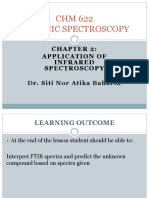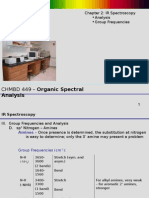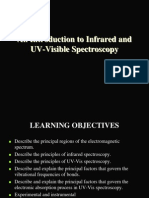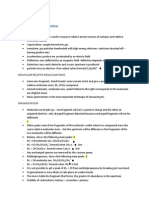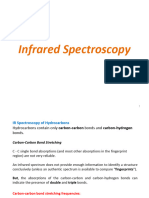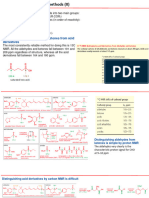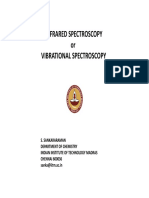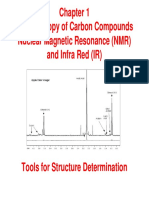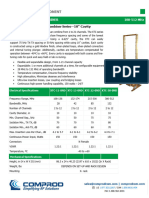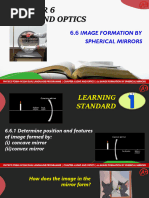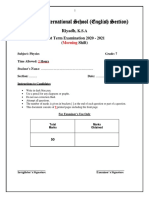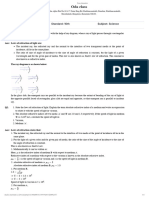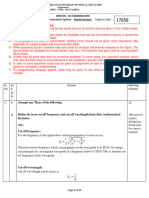Infra Red
Infra Red
Uploaded by
DennianasCopyright:
Available Formats
Infra Red
Infra Red
Uploaded by
DennianasOriginal Description:
Copyright
Available Formats
Share this document
Did you find this document useful?
Is this content inappropriate?
Copyright:
Available Formats
Infra Red
Infra Red
Uploaded by
DennianasCopyright:
Available Formats
19/02/2014
Introduction
Infrared Spectroscopy
Spectroscopy is an analytical technique which helps determine structure It destroys little or no sample The amount of light absorbed by the sample is measured as wavelength is varied
Types of Spectroscopy
Infrared (IR) spectroscopy measures the bond vibration frequencies in a molecule and is used to determine the functional group Mass spectrometry (MS) fragments the molecule and measures the masses Nuclear magnetic resonance (NMR) spectroscopy detects signals from hydrogen atoms and can be used to distinguish isomers Ultraviolet (UV) spectroscopy uses electron transitions to determine bonding patterns
3
Electromagnetic Spectrum
Examples: X rays, microwaves, radio waves, visible light, IR, and UV Frequency and wavelength are inversely proportional c = ln, where c is the speed of light Energy per photon = hn, where h is Plancks constant
4
19/02/2014
The Spectrum and Molecular Effects
The IR Region
Just below red in the visible region Wavelengths usually 2.5-25 mm More common units are wavenumbers, or cm-1, the reciprocal of the wavelength in centimeters (4000-400 cm-1) Wavenumbers are proportional to frequency and energy
=>
5
Molecular Vibrations
Light is absorbed when radiation frequency = frequency of vibration in molecule Covalent bonds vibrate at only certain allowable frequencies
Associated with types of bonds and movement of atoms
Baseline
IR Spectrum
Absorbance/ Peak
Vibrations include stretching and bending
No two molecules will give exactly the same IR spectrum (except enantiomers) Simple stretching: 1600-3500 cm-1 Complex vibrations: 400-1400 cm-1, called the fingerprint region
7 8
19/02/2014
Interpretation
Looking for presence/absence of functional groups Correlation tables
Wade Ch. 12 and Appendices 2A and 2B Lehman OP-36 and back cover
Carbon-Carbon Bond Stretching
Stronger bonds absorb at higher frequencies:
C-C C=C CC 1200 cm-1 1660 cm-1 2200 cm-1 (weak or absent if internal)
A polar bond is usually IR-active A nonpolar bond in a symmetrical molecule will absorb weakly or not at all
9
Conjugation lowers the frequency:
isolated C=C conjugated C=C aromatic C=C 1640-1680 cm-1 1620-1640 cm-1 approx. 1600 cm-1
10
Carbon-Hydrogen Stretching
Bonds with more s character absorb at a higher frequency
sp3 C-H, just below 3000 cm-1 (to the right) sp2 C-H, just above 3000 cm-1 (to the left) sp C-H, at 3300 cm-1
An Alkane IR Spectrum
11
12
19/02/2014
An Alkene IR Spectrum
An Alkyne IR Spectrum
13
14
O-H and N-H Stretching
Both of these occur around 3300 they look different cm-1, but
An Alcohol IR Spectrum
Alcohol O-H, broad with rounded tip Secondary amine (R2NH), broad with one sharp spike Primary amine (RNH2), broad with two sharp spikes No signal for a tertiary amine (R3N)
15
16
19/02/2014
An Amine IR Spectrum
Carbonyl Stretching
The C=O bond of simple ketones, aldehydes, and carboxylic acids absorb around 1710 cm-1 Usually, its the strongest IR signal Carboxylic acids will have O-H also Aldehydes have two C-H signals around 2700 and 2800 cm-1
17 18
A Ketone IR Spectrum
An Aldehyde IR Spectrum
19
20
19/02/2014
O-H Stretch of a Carboxylic Acid
This O-H absorbs broadly, 2500-3500 cm-1, due to strong hydrogen bonding
Variations in C=O Absorption
Conjugation of C=O with C=C lowers the stretching frequency to ~1680 cm-1 The C=O group of an amide absorbs at an even lower frequency, 1640-1680 cm-1 The C=O of an ester absorbs at a higher frequency, ~1730-1740 cm-1 Carbonyl groups in small rings (5 Cs or less) absorb at an even higher frequency
21
22
An Amide IR Spectrum
Carbon - Nitrogen Stretching
C - N absorbs around 1200 cm-1 C = N absorbs around 1660 cm-1 and is much stronger than the C = C absorption in the same region C N absorbs strongly just above 2200 cm-1. The alkyne C C signal is much weaker and is just below 2200 cm-1
23 24
19/02/2014
A Nitrile IR Spectrum
Summary of IR Absorptions
25
26
Strengths and Limitations
IR alone cannot determine a structure Some signals may be ambiguous The functional group is usually indicated The absence of a signal is definite proof that the functional group is absent Correspondence with a known samples IR spectrum confirms the identity of the compound
27
http://www.aist.go.jp/RIODB/SDBS/cgibin/direct_frame_top.cgi?lang=eng
28
You might also like
- JBL Audio Engineering for Sound ReinforcementFrom EverandJBL Audio Engineering for Sound ReinforcementRating: 5 out of 5 stars5/5 (2)
- 4.11 Structure DeterminationDocument46 pages4.11 Structure DeterminationJaslinder Kaur Dhillon100% (1)
- Phased Array Calculations With AnswersDocument8 pagesPhased Array Calculations With AnswersLương Hồ Vũ100% (1)
- Topic: Accurately Testing Fiber Optic Cables: Table of Contents: The FOA Reference Guide To Fiber OpticsDocument11 pagesTopic: Accurately Testing Fiber Optic Cables: Table of Contents: The FOA Reference Guide To Fiber OpticsedgarcooNo ratings yet
- Albert Szent Gyorgyi - BioenergeticsDocument166 pagesAlbert Szent Gyorgyi - Bioenergeticsokowrygo100% (5)
- 10 03 2006 Biophysics 2Document30 pages10 03 2006 Biophysics 2api-3696530No ratings yet
- IR SPECTROSCOPY Notes FullDocument5 pagesIR SPECTROSCOPY Notes FullKartik KuteNo ratings yet
- IR Lecture UpdateDocument141 pagesIR Lecture UpdateAnonymous epaORjlkgNo ratings yet
- Textile PhysicsDocument11 pagesTextile PhysicsAl AminNo ratings yet
- Infrared SpectrosDocument41 pagesInfrared SpectrosSupriya MoreyNo ratings yet
- Ftir SpectrosDocument36 pagesFtir SpectrosHafiz Mudaser AhmadNo ratings yet
- Infrared SpectrosDocument30 pagesInfrared Spectrosifebriandewi87No ratings yet
- Kuliah Infra Merah-LengkapDocument63 pagesKuliah Infra Merah-LengkapM Nur M. MahmudNo ratings yet
- Lecture 4 IR Spectrum AnalysisDocument43 pagesLecture 4 IR Spectrum AnalysiskhadijahhannahNo ratings yet
- 0302 紅外線光譜儀 孫仲銘老師Document47 pages0302 紅外線光譜儀 孫仲銘老師周浩銘No ratings yet
- Session 7 (IR)Document27 pagesSession 7 (IR)ashenafiNo ratings yet
- Structure Determination For Organic CompoundsDocument5 pagesStructure Determination For Organic CompoundsHanh DuongNo ratings yet
- ASS Instrumental OrganicDocument17 pagesASS Instrumental OrganicMohamed SakrNo ratings yet
- 2 PraktIPATerpadu-IR SpectrosDocument32 pages2 PraktIPATerpadu-IR SpectrosSurya SimamoraNo ratings yet
- Organic 7Document41 pagesOrganic 7sm737744No ratings yet
- CHEM 200 IR SpectrosDocument35 pagesCHEM 200 IR SpectrosIngrid LacsonNo ratings yet
- WADE7 Lecture 12Document55 pagesWADE7 Lecture 12Christian PridayNo ratings yet
- Elusidasi Struktur Senyawa Organik-Minggu 2 Dan 3-FTIRDocument56 pagesElusidasi Struktur Senyawa Organik-Minggu 2 Dan 3-FTIRmuhammademiralyavich9876No ratings yet
- Infrared Spectroscopy and Mass SpectrometryDocument44 pagesInfrared Spectroscopy and Mass SpectrometrynofacejackNo ratings yet
- IR SpectrosDocument33 pagesIR SpectrosKikiMariaNo ratings yet
- CHMBD 449 - Organic Spectral: AnalysisDocument43 pagesCHMBD 449 - Organic Spectral: AnalysisIleana ManciuleaNo ratings yet
- CH 12 - IR GuideDocument13 pagesCH 12 - IR GuideAron StubbsNo ratings yet
- 2 PraktIPATerpadu-IR SpectrosDocument32 pages2 PraktIPATerpadu-IR Spectrosvsvsuresh2099No ratings yet
- Infra-Red Spectrosco Py: Dr. Mohamed Ibrahim M. Pharm in Drug Quality ControlDocument40 pagesInfra-Red Spectrosco Py: Dr. Mohamed Ibrahim M. Pharm in Drug Quality Controlmimyabdo77No ratings yet
- Infrared SpectrosDocument4 pagesInfrared Spectrosjellybean07100% (1)
- Infrared SpectrosDocument9 pagesInfrared Spectrosbac_nobita7657No ratings yet
- Infrared SpectrosDocument110 pagesInfrared SpectrosBHARTI GAURNo ratings yet
- Introduction To Interpretation of Infrared SpectraDocument3 pagesIntroduction To Interpretation of Infrared SpectraBenni WewokNo ratings yet
- Raw Material Analysis-IRDocument58 pagesRaw Material Analysis-IRDilla Wulan NingrumNo ratings yet
- Ir ElucidationDocument25 pagesIr ElucidationMartyr LeoNo ratings yet
- Chm622 Chapter2 Ftir AtikaDocument42 pagesChm622 Chapter2 Ftir Atikasharifah sakinah syed soffianNo ratings yet
- CHMBD 449 - Organic Spectral: AnalysisDocument40 pagesCHMBD 449 - Organic Spectral: AnalysisIleana ManciuleaNo ratings yet
- Infrared SpectroscopyDocument12 pagesInfrared Spectroscopysanjay sNo ratings yet
- INFRARED SPECTROSCOPY (Full Lecture)Document74 pagesINFRARED SPECTROSCOPY (Full Lecture)Alexine CharlonNo ratings yet
- IR spectroscopy (3)Document9 pagesIR spectroscopy (3)ummejaveriya8No ratings yet
- Chapter 12 - Infrared Spectroscopy and Mass SpectrometryDocument47 pagesChapter 12 - Infrared Spectroscopy and Mass SpectrometryFadllah Farah Diba100% (1)
- IR SpectraDocument5 pagesIR SpectraXyphrus EmeritusNo ratings yet
- Infrared Tutorial 2Document71 pagesInfrared Tutorial 2Hammo Ez AldienNo ratings yet
- INTRODUCTION To IR 2Document21 pagesINTRODUCTION To IR 2Rabia KhanNo ratings yet
- Infrared Spectroscopy: CAPE Chemistry Unit 2Document24 pagesInfrared Spectroscopy: CAPE Chemistry Unit 2dela2No ratings yet
- An Introduction To Infrared and UV-Visible SpectrosDocument45 pagesAn Introduction To Infrared and UV-Visible SpectrosArvandz_tea100% (1)
- Infrared Spectroscopy: Conformational IsomersDocument7 pagesInfrared Spectroscopy: Conformational IsomersRiyan NazarudinNo ratings yet
- IR SpectrosDocument44 pagesIR SpectrosVansh YadavNo ratings yet
- Structure Determination: Mass SpectrometryDocument3 pagesStructure Determination: Mass SpectrometrySharmeen HelalNo ratings yet
- Chapter3 IR1Document34 pagesChapter3 IR1dokdangNo ratings yet
- Publication 3 2208 1587Document63 pagesPublication 3 2208 1587Tharakeshwari MuraliNo ratings yet
- Infrared Spectroscopy and Mass Spectrometry: Organic Chemistry, 5Document47 pagesInfrared Spectroscopy and Mass Spectrometry: Organic Chemistry, 5muhammadalfian4258No ratings yet
- Infrared SpectrosDocument10 pagesInfrared SpectrosVal's Very OwnNo ratings yet
- Infrared SpectrosDocument63 pagesInfrared SpectrosAsim Alaa Al SalehiNo ratings yet
- SpectrosDocument39 pagesSpectrosJames Baben0% (1)
- IR Spectroscopy TutorialDocument36 pagesIR Spectroscopy TutorialreddygrNo ratings yet
- CH221 10Document28 pagesCH221 10ankushtoppo25No ratings yet
- Spectroscopy IR NMR Supplemental ReadingDocument14 pagesSpectroscopy IR NMR Supplemental Readingmayagal1707No ratings yet
- Infrared SpectrosDocument17 pagesInfrared SpectrosJasper DumalaogNo ratings yet
- Infrared Spectroscopy or Vibrational SpectrosDocument18 pagesInfrared Spectroscopy or Vibrational SpectrosVignesh Raja PNo ratings yet
- 1CHAPTER 1 Spectroscopy of C CompoundDocument47 pages1CHAPTER 1 Spectroscopy of C CompoundEustance JuanNo ratings yet
- The Science of Color 2Document55 pagesThe Science of Color 2jacob richardsonNo ratings yet
- MEMS and Piezo Actuator Based Fabry-Perot Interferometer Technologies and Applications at VTTDocument12 pagesMEMS and Piezo Actuator Based Fabry-Perot Interferometer Technologies and Applications at VTTsunilsheelavantNo ratings yet
- XTC 11 0NDDocument1 pageXTC 11 0NDQasem Al-AyedNo ratings yet
- 6.6 Image Formation by Spherical Mirrors (Full Answers)Document32 pages6.6 Image Formation by Spherical Mirrors (Full Answers)hasnitah81No ratings yet
- EDFADocument38 pagesEDFAMustafa_elecNo ratings yet
- G7 Phy QP - MorningDocument9 pagesG7 Phy QP - MorningRossy cookieNo ratings yet
- Light WorksheetDocument11 pagesLight Worksheetkobayashirei602No ratings yet
- Estimating Turbidity (NTU) From Absorption Data: Kevin L. Goodner, PH.DDocument4 pagesEstimating Turbidity (NTU) From Absorption Data: Kevin L. Goodner, PH.Djackactforever4No ratings yet
- @bohring Bot 20-01-24 SR Star Co Scmodel A, B&C Jee Main GTM 22nDocument18 pages@bohring Bot 20-01-24 SR Star Co Scmodel A, B&C Jee Main GTM 22nayushdayama111No ratings yet
- Physiology of Colour Vision 150731174500 Lva1 App6892Document40 pagesPhysiology of Colour Vision 150731174500 Lva1 App6892Shimaa HassanNo ratings yet
- WORKSHEET Phy lab-IIDocument12 pagesWORKSHEET Phy lab-IIzithNo ratings yet
- Colour Vision AnomaliesDocument27 pagesColour Vision AnomaliesGershon Hayford100% (1)
- Chemistry SolutionDocument85 pagesChemistry SolutionxanshahNo ratings yet
- Binocular and Telescope GuideDocument16 pagesBinocular and Telescope Guidemonitor2xNo ratings yet
- Physics: Crash Course For JEE Main 2020Document16 pagesPhysics: Crash Course For JEE Main 2020Ayush SharmaNo ratings yet
- IPAA 2.1m - 92Kg - 2100x498x524 (Top Module 57Kg + Base Module 35Kg)Document4 pagesIPAA 2.1m - 92Kg - 2100x498x524 (Top Module 57Kg + Base Module 35Kg)Florian LoisonNo ratings yet
- Sources of Light 1Document22 pagesSources of Light 1Albert Corsame UmbacNo ratings yet
- Alarm NoDocument3 pagesAlarm Noajayatm477No ratings yet
- Waveguide Grating Coupler With Subwavelength MicroDocument4 pagesWaveguide Grating Coupler With Subwavelength MicroPaola GongoraNo ratings yet
- Plancks Constant Experiment ReportDocument5 pagesPlancks Constant Experiment Reportharsh guptaNo ratings yet
- Brochure 3D OCT-1000Document6 pagesBrochure 3D OCT-1000Alberto GilNo ratings yet
- Gowri 2019Document6 pagesGowri 2019Ardhy ArmawanNo ratings yet
- Radiography QuizletDocument15 pagesRadiography Quizletmeli100% (1)
- WMD 4th Gen QuestDocument236 pagesWMD 4th Gen QuestArmstrong Tower100% (1)
- Einstein Relations: Prof - Siva PrasadDocument11 pagesEinstein Relations: Prof - Siva PrasadRenuNo ratings yet
- 2018 Winter Model Answer PaperDocument35 pages2018 Winter Model Answer Paperharshy0816No ratings yet
- MODULE 1 History of PhotographyDocument143 pagesMODULE 1 History of PhotographyHanz RebornNo ratings yet

